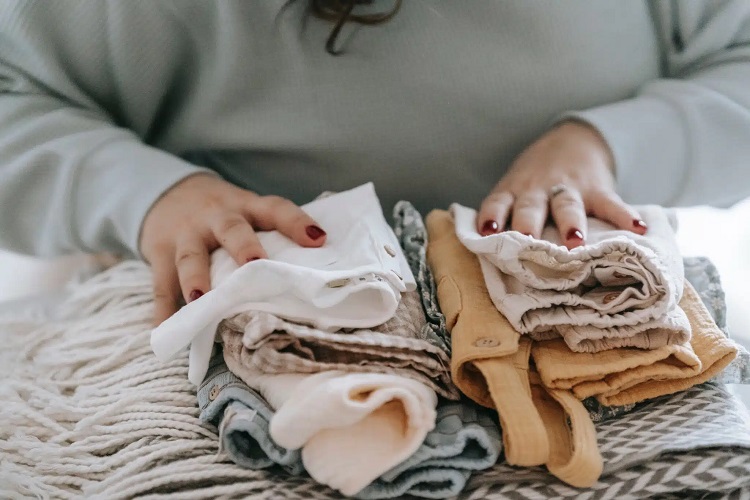
Newborn Clothing: How to Choose the Right Materials for Your Baby’s Comfort
The journey of parenthood comes with a lot of decisions, and one of the most crucial decisions revolves around dressing your little one. Newborns have extremely sensitive skin, which is why the material of their clothing has a big impact on their health. The ideal choices are natural materials, such as cotton, linen, wool, etc. Read on to learn more about them, so that you can make an informed purchase!
Cotton

If your baby’s health and comfort are important to you, one of the best choices you can make is to opt for extra comfy cotton newborn rompers. This natural fabric is popular for its breathability, allowing air circulation that helps regulate a baby’s body temperature. This is particularly important for infants who still can’t withstand a lot of heat.
Their skin is delicate and requires extra tender loving care. The soft yet strong fibres of cotton make it the perfect fabric for baby rompers, blankets, towels, and anything else that meets your baby’s sensitive skin. You can rest easy knowing that the gentle texture won’t rub abrasively or cause irritation. It will provide a cosy cocoon for your little one, especially during those precious nighttime swaddles.
Anyone who has been through the whirlwind of spills and messes that come with parenting knows the value of a resilient fabric. Cotton newborn rompers are made from one of the strongest natural fibres available and they’re not afraid to get dirty. They’re more durable, colourfast, and resistant to pilling and shrinking compared to other fabrics. This durability means your little one’s clothes can handle the constant wear and tear that comes with their active, on-the-go lifestyle.
For parents of babies with allergies or sensitivities, it’s important to mention that cotton infant rompers are hypoallergenic. Because cotton is a natural fibre, it seldom results in skin irritation or allergic reactions. Considering the delicacy of newborns’ skin in their early months, cotton keeps them comfortable without the worry of rashes or discomfort.
The absorbent quality of cotton rompers for newborn babies further solidifies its position as an ideal fabric for baby essentials. Whether it’s clothing, diapers, or towels, this material is breathable and absorbent, which makes it perfect for wicking moisture away from your baby’s sensitive skin. This helps keep them cool and ensures they stay dry and comfortable throughout the day, a crucial factor in maintaining a happy, contented baby.
Linen
Linen is another popular material that many manufacturers use for making newborn clothes. Like cotton, it’s known for the comfort, absorbency, durability, and hypoallergenic properties it offers. It’s also lightweight, so your little one will hardly feel the material touching their skin. Manufacturers often use this material for baby dresses, skirts, and trousers. Fun fact: linen comes from flax plants, which grow in the Mediterranean region.
Wool

Wool is another fantastic natural material for newborn clothes, as it keeps your child warm and cosy. This makes it an ideal material for the cold winter months. Clothing items like sweaters, blankets, and beanies are most commonly made of this material. It’s important to note that wool can sometimes cause itching, so make sure that you can feel the clothing with your hands before you purchase it.
Silk
I’m sure that you already know about the undeniable luxurious feel that silk brings to your scarves and slip dresses. Surprisingly, this popular material doesn’t only serve looks. Baby clothes made of silk are incredibly soft to the skin and hypoallergenic, making them a great choice for your little one’s sensitive skin.
Bamboo

Not many people are familiar with bamboo clothing, as it’s relatively rare on the market, but this is another fantastic alternative for newborns. This material is breathable, moisture-wicking, hypoallergenic and super soft on your little one’s skin. It’s also an eco-friendly choice, which is great news for all the environmentally-conscious parents out there.
Which Fabrics Are Bad for Babies?
Synthetic fabrics might be tempting with their trendy designs, but some of them can be seriously harmful to your baby’s well-being. For instance:
- Polyester and nylon might look good, but they’re often manufactured using petrochemical-based additives that emit not-so-friendly Volatile Organic Compounds (VOCs). These compounds can lead to asthma, allergies, and other respiratory issues for your little bundle of joy;
- Then there’s Teflon – the same material that keeps your non-stick pans non-sticky. Wrinkle-resistant clothes might sound like a dream, but if they contain Teflon, there’s a catch. They can catch fire when exposed to heat, and they emit harmful toxic gases;
- Rayon, despite being derived from wood pulp, undergoes chemical treatments that can cause headaches, nausea, and other health hazards;
- Acrylic, masquerading as a cheaper alternative to wool, is made using a cocktail of toxic substances that can be harmful to your baby’s delicate system;
- Acetate and triacetate, made from wood fibres, undergo extensive chemical treatments for that sleek finish. Research suggests they can cause skin allergies, rashes, and even shortness of breath in little ones.
Shopping for your baby is a big joy of parenthood. But you should be smart about it – opt for natural fabrics that are a safer bet than the synthetic alternatives. Synthetic clothes might look good but can potentially be a health hazard for your little one. After all, a healthy and happy baby is the ultimate style statement.


